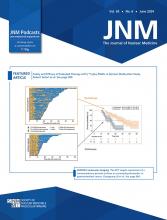TO THE EDITOR: I have read with great interest the article by Fettahoglu et al. (1) on the comparison of early-phase amyloid PET tracer and [15O]H2O and found it to be highly captivating. The authors successfully demonstrated a linear relationship between early-phase [18F]florbetaben and [15O]H2O with minimal bias.
Although numerous studies highlight the utility of early-phase amyloid PET, I was inclined to suggest the necessity for contrast correction (2) in early-phase images, as the first-pass extraction fraction of these tracers has not been estimated to be sufficiently high. For instance, the K1 of [18F]florbetaben was estimated to be 0.187 mL/mL/min in an Alzheimer disease patient, 0.216 mL/mL/min in a healthy control subject (3), and 0.226 mL/g/min in another estimation (4). Consequently, the first-pass extraction fraction (E) of [18F]florbetaben would be approximately 0.5, considering a cerebral blood flow (F) of around 50 mL/100 g/min and K1 = FE.
A low first-pass extraction fraction tracer would result in underestimation in regions with high cerebral blood flow, adhering to the Renkin–Crone equation,  (e is the Napier constant). The permeability surface area product (PS) of an extraction fraction of 0.5 at a cerebral blood flow of 50 mL/100 g/min is theoretically 35 mL/100 g/min. However, the data presented by Fettahoglu et al. (1) indicate that this underestimation was minimal, suggesting that the first-pass extraction fraction of amyloid tracers may be sufficiently high and comparable to that of H2O. Consequently, there may be no need for contrast correction.
(e is the Napier constant). The permeability surface area product (PS) of an extraction fraction of 0.5 at a cerebral blood flow of 50 mL/100 g/min is theoretically 35 mL/100 g/min. However, the data presented by Fettahoglu et al. (1) indicate that this underestimation was minimal, suggesting that the first-pass extraction fraction of amyloid tracers may be sufficiently high and comparable to that of H2O. Consequently, there may be no need for contrast correction.
The perplexing dissociation between the PS value of water (more than 100 mL/100 g/min (5)) and the above-estimated PS value of [18F]florbetaben (35 mL/100 g/min) may be attributed to various factors. First, estimating kinetic parameters using the least-square method might pose challenges. Second, there could be an overestimation of radioactivity in plasma. Third, the cerebral blood flow of the participants may be smaller than expected.
Mysteries persist in the kinetic analysis of nuclear medicine, and further investigations are essential to unravel and bridge these gaps.
DISCLOSURE
No potential conflict of interest relevant to this article was reported.
Masashi Kameyama
Tokyo Metropolitan Institute for Geriatrics and Gerontology, Tokyo, Japan
E-mail: kame-tky{at}umin.ac.jp
Footnotes
Published online Apr. 4, 2024.
- © 2024 by the Society of Nuclear Medicine and Molecular Imaging.
REFERENCES
- Revision received January 22, 2024.
- Accepted for publication January 31, 2024.







